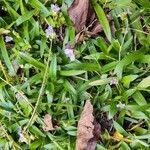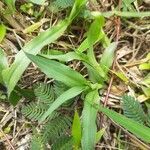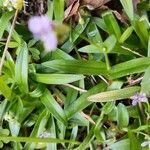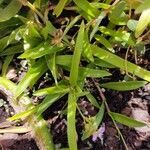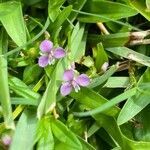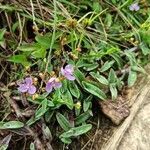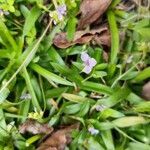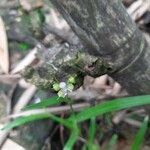A creeping herb. It lies along the ground. It keeps growing from year to year. It forms roots at the nodes. The base has a thickened root or tuber. The leaves are narrow and oval. They form a sheath around the stem. Leaves taper towards the tip. The leaves can be 9 cm long. The leaf like structure around the flower is boat shaped. The flowers are pale blue and about 0.6 cm across. They occur in a small cluster near the ends of branches. The flowers open about midday. The fruit is a 3 celled capsule which splits open. There are 2 seed in each cell. The seeds are angular and the seed coat has pits.
Herbs, annual, unbranched to much branched, 8--30 cm. Leaves spirally arranged; blade linear or linear-lanceolate to lanceolate-oblong, 1.5--7(--18) ´ 0.3--0.8 cm. Inflorescences terminal or terminal and axillary; cymes few-flowered, solitary or fascicled, long-pedunculate; bracteoles caducous, scars spaced less than 2 mm apart. Flowers bisexual, slightly bilaterally symmetric, 4--6 mm wide; sepals 2--3 mm; petals pinkish purple or violet, 3--3.5(--6) mm; fertile stamens 2; filaments bearded; staminodes 4. Capsules 2.5--5 mm. Seeds 2 per locule, deeply pitted, 1.3--1.8 mm. 2n = 20 (Trinidad).
A weak, prostrate or decumbent herb with stem often rooting at nodes
Flowers small, white to purple, open from 11 a.m. to 1 p.m.
